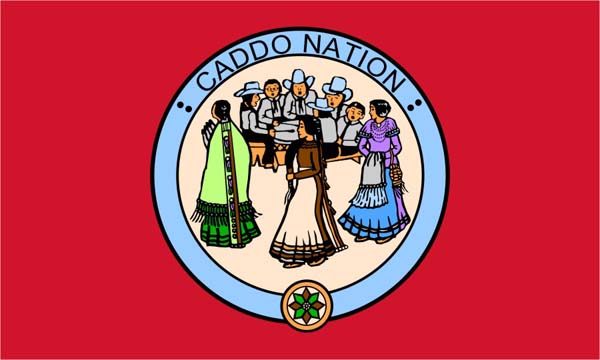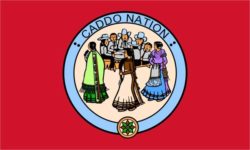Caddo Nation
The Caddo people, who began to inhabit the Red River valley approximately 2,500 years ago, were eventually pushed out of their traditional territory by Anglo-American immigrants.
This entry is 7th Grade level View Full Entry

WIKIMEDIA COMMONS
Flag of the Caddo Nation.
Where have the Caddo people historically lived, and how did they interact with their environment?
Caddo people began to inhabit the Red River valley approximately 2,500 years ago. Around that time, the ancestors of the southern Caddos began to settle in permanent villages, build the first mounds, cultivate plants, and develop the use of ceramics. The backbone of the Caddo world was the Red River, but their extensive traditional territory, known as the Caddoan area, included present-day southwestern Arkansas, northwestern Louisiana, northeastern Texas, and southeastern Oklahoma.
The early Caddos settled in hamlets and spread-out villages and occupied ceremonial centers with mounds for elite burials and ritual activities. They produced elaborate cane basketry, shell work, and ceramics and were renowned for their bois d’arc (Osage orange) bows, which they traded, along with salt and other goods, across the American Southeast and southern plains. The Caddo people were sedentary and practiced agriculture, growing maize, beans, squash, and pumpkins. They also gathered seasonal foods such as nuts and berries and hunted extensively.
Caddos lived in rural communities along rivers and streams. At the time of European contact in the late seventeenth century, the era of Caddo mound building was ending, although Caddo people continued to utilize some mounds for ceremonial activities. Caddos also participated in a huge trading network. There were at least sixteen separate Caddo groups at the end of the 1600s, but by the middle of the eighteenth century, they were collectively identified by Europeans as “Caddo,” taken from the word “Kadohadacho,” the name of the largest and most powerful group of Caddos in the Red River valley.
How did contact with European powers affect the Caddo?
The population of Caddos at the beginning of European colonization (c.1680–1700) is unclear. Estimates range from 6,000 to as many as 250,000 people. However, is certain is that by the time France established an outpost at Natchitoches in 1714, the Caddo people had already suffered drastic population loss resulting from the introduction of European diseases such as influenza (the flu) and smallpox, to which they had no immunities. The Caddo population continued to decline throughout the remainder of the colonial period and beyond, falling to about five hundred people in the 1890s.
Throughout the French colonial period, Caddos were treated as valued allies whose goodwill was secured through kinship as well as access to European goods, annual gifts, and advantages in trade. To the west Spain had established largely unsuccessful missions among Texas Caddos whom were instead drawn to French traders in Louisiana. Upon assuming control of the colony in 1763, Spain was forced to model its policy toward Native people on French practices. Spanish administrators appointed French Creoles with whom Caddos had long-standing relationships to administer trade with Native nations.
How did the Louisiana Purchase, and subsequent Anglo-American immigration affect the Caddo people?
Spain secretly returned Louisiana to France in 1800. Three years later the United States purchased Louisiana and gained control over the port of New Orleans and the Mississippi River. Under American government, conditions for Caddos dramatically and forever changed. Vast, exploitable natural resources and tremendous agricultural potential drew thousands of American immigrants across the Mississippi River to establish plantations, farms, and businesses. The present state of Louisiana west of the Mississippi River saw fourteen thousand Anglo-American immigrants arrive by 1808. North and west of New Orleans, cotton and sugar plantations built on enslaved labor flourished and, by 1812, cleared fields extended up the Red River as far as Natchitoches.
At first American administrators maintained the status quo when interacting with Louisiana’s Indigenous groups. As trade between Native and European-American groups fell in importance, however, and as more Americans realized the agricultural potential of the rich Red River valley, Caddos found themselves increasingly disempowered. Competition for territory created animosity between the American immigrants and the Caddo people. In 1835 the Red River Caddos were forced to cede their traditional territory east of the Sabine River to the United States and joined their relatives in Spanish Texas. The Caddo Nation found a permanent home in 1859, when they settled in the Washita River valley in present-day Oklahoma. Not until 1935 were the Caddo people invited back to their homelands for the Shreveport centennial celebration. The city invited Caddos to participate again during the sesquicentennial in 1985.
Where are the Caddo people today, and how have they preserved their unique culture?
The Caddo Nation has maintained its autonomy as a sovereign tribal nation with its own unique set of songs and dances, material culture, and language. The Turkey Dance is a series of more than fifty songs that are remembered in many Caddo dialects and recount occurrences in tribal history, including important battles and the creation of Caddo Lake. The Drum Dance documents Caddo cosmology and origins. In it, drummers lead dancers clockwise around the ground, stopping at each of the four cardinal directions. When the procession has completed its journey, Caddo participants have effectively reenacted their cultural beginnings.
The contemporary tribal complex, which includes a museum and two community dance grounds, is situated in Binger, Caddo County, Oklahoma. The tribal administration includes the Cultural Preservation Office and Caddo Repatriation Committee, which are made up of elders who offer guidance on archaeological and historical issues. Two cultural groups—the Caddo Culture Club and the Hasinai Club—work with tribal youth to preserve Caddo culture. In the twenty-first century Caddo people maintain close ties to their traditional homelands in Louisiana, returning often to honor their ancestors, revisit important sites, consult with academic and museum specialists, and dance on their ancient lands.
